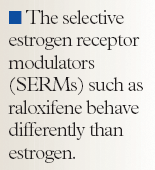- Safety & Recalls
- Regulatory Updates
- Drug Coverage
- COPD
- Cardiovascular
- Obstetrics-Gynecology & Women's Health
- Ophthalmology
- Clinical Pharmacology
- Pediatrics
- Urology
- Pharmacy
- Idiopathic Pulmonary Fibrosis
- Diabetes and Endocrinology
- Allergy, Immunology, and ENT
- Musculoskeletal/Rheumatology
- Respiratory
- Psychiatry and Behavioral Health
- Dermatology
- Oncology
ASA ISC 2006: Raloxifene may offer stroke protection in women with high estradiol levels
In a post-hoc analysis, raloxifene (Evista, multiple manufacturers) appeared to attenuate stroke risk caused by high estradiol levels in postmenopausal women, said Jennifer S. Lee, MD, at the American Stroke Association's International Stroke Conference 2006 in Kissimmee, Fla.

In clinical trials, "both estrogen alone and in combination therapy have conferred about a 40% increased risk of stroke compared with placebo," said Dr Lee, from California Pacific Medical Research Institute and the University of California, San Francisco. "A recent meta-analysis of 28 randomized trials showed a significant 29% increased risk in ischemic stroke with hormone therapy, which typically increases serum estradiol levels well into the premenopausal range."
In addition, in the Women's Estrogen for Stroke Trial, women with stroke or transient ischemic attack who were taking estrogen had a 3-fold increased risk of fatal stroke and more severe recurrent stroke injuries.
In the Multiple Outcomes of Raloxifene Evaluation (MORE) to assess the effects of raloxifene, 60 or 120 mg/d, on bone mineral density and vertebral fracture over a 4-year period, baseline estradiol measurements were obtained in 7,290 of the 7,705 women enrolled. Participants were at least 2 years postmenopausal, were aged 80 years or younger, and had no stroke or venous thromboembolic disease in the previous 10 years.
Among the 2,447 women given placebo, 1,227 (50%) had undetectable levels of estradiol. Fifty percent of the remaining 1,220 had levels ≥16 pmol/L. The women with estradiol levels ≥16 pmol/L, representing the highest quartile of estradiol levels, had 2.5 times the stroke risk compared with women with lower estradiol levels (P<.015).
In women with lower estradiol levels, taking raloxifene did not significantly affect their risk of stroke compared with placebo. In women with higher estradiol levels, however, raloxifene, 60 or 120 mg/d, reduced the risk of stroke by 55% (P=.11). (The conventional P value used to determine significance in tests of interaction is 0.10, she said.)
The number needed to treat with raloxifene to prevent one stroke in women with the highest endogenous estradiol levels was 78, she said.
